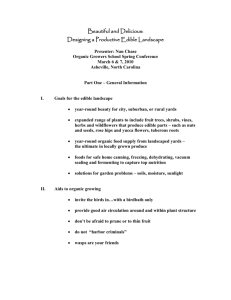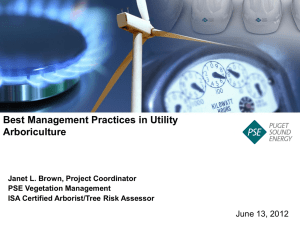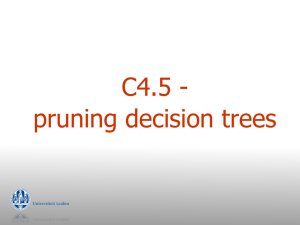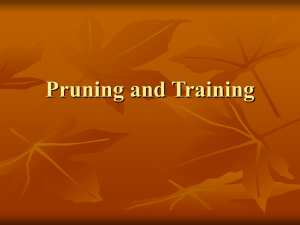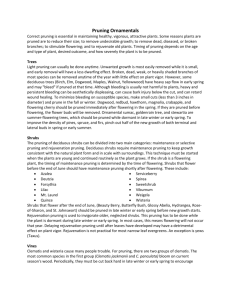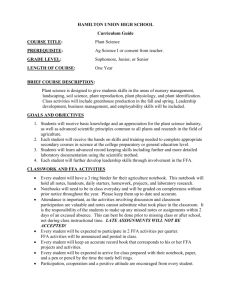State Standards Met by Objectives Oregon Skill Sets Met by
advertisement
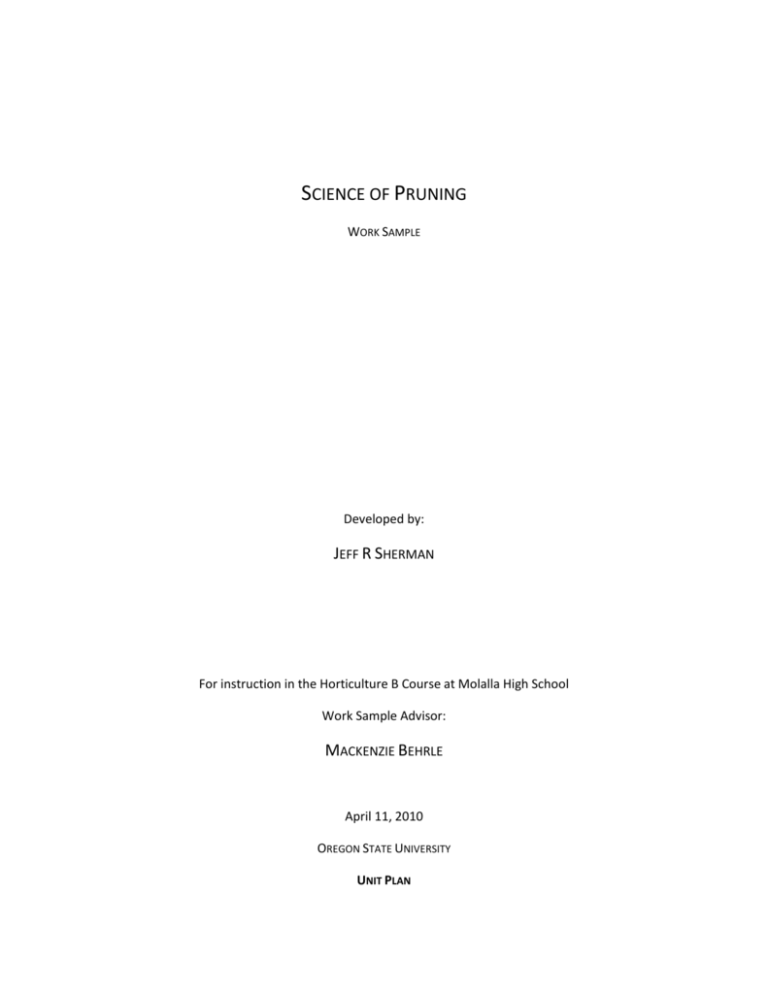
SCIENCE OF PRUNING WORK SAMPLE Developed by: JEFF R SHERMAN For instruction in the Horticulture B Course at Molalla High School Work Sample Advisor: MACKENZIE BEHRLE April 11, 2010 OREGON STATE UNIVERSITY UNIT PLAN SCIENCE OF PRUNING SUBJECT Agriculture Agriculture STRAND 02.01.01.02 04.01.05.01 Agriculture 06.01.01.01 Agriculture 06.01.02.00 Agriculture Agriculture Agriculture 06.02.01.05 06.02.04.01 06.02.05 Agriculture Agriculture Agriculture Agriculture Agriculture 10.02.01 10.02.02.01 10.02.02 10.02.03.04 10.02.03.05 CRLS CRLS CRLS CRLS CS.CD.01 CS.CD.02 CS.EF.01 CS.PM.02 CRLS CS.TW.01 English EL.HS.RE.03 English EL.HS.RE.05 English EL.HS.RE.08 English EL.HS.RE.10 English EL.HS.SL.07 English EL.HS.SL.12 Plant Plant 01.02 01.02.02.c Plant 01.02.02.a CONTENT/GOALS Increase reading skills through reading challenging material Prepare and deliver presentations (e.g., training, marketing plans and information updates). Identify major regulatory areas related to a specific industry or workplace environment Demonstrate the importance of safety, health and environmental compliance and performance in an agricultural workplace for all employees Demonstrate specific actions to avoid hazardous work situations Identify general workplace safety hazards Demonstrate knowledge and skills that prevent health and safety problems in the workplace Select the appropriate tool to perform a given task Describe the characteristics of a tool in need of maintenance Maintain tools for efficient work use Demonstrate the safe use of a tool or piece of equipment Describe the safety regulations associated with specific tools and equipment Assess personal characteristics related to educational and career goals. Research and analyze career and educational information. Apply academic knowledge and technical skills in a career context. Plan, organize, and complete projects and assigned tasks on time, meeting agreed upon standards of quality. Identify different types of teams and roles within each type of team; describe why each role is important to effective teamwork. Make connections to text, within text, and among texts across the subject areas. Match reading to purpose--location of information, full comprehension, and personal enjoyment. Understand, learn, and use new vocabulary that is introduced and taught directly through informational text, literary text, and information across subject areas. Determine meanings of words using contextual and structural clues. Use props, visual aids, graphs, and/or electronic media to enhance the appeal and accuracy of rehearsed presentations (not part of scoring guide criteria). Evaluate the clarity, quality, and effectiveness of a speaker’s important points, arguments, evidence, organization of ideas, delivery, diction, and syntax. Apply knowledge of plant anatomy and the functions of plant systems Relate the active and passive transport of mineral into and through the root system to plant nutrition Identify the components, the types and the functions of plant roots Plant Plant Plant 01.02.03.a 01.02.06.a 01.03 Plant 02.01.02.c Plant Plant Plant 02.02 03.01 03.01.03.a Plant Plant Plant 03.02.02.a 03.02.03.a 03.02.04.b Plant Plant 03.02.05.a 03.03.05.b Identify the components and the functions of plant terms Explain the functions and components of seeds and fruit Apply knowledge of plant physiology and energy conversion to plant system Design, implement and evaluate a plan to maintain optimal conditions for plant growth Prepare growing media for use in plant systems Demonstrate plant propagation techniques Describe optimal conditions for asexual propagation and demonstrate techniques used to propagate plants by cuttings, division, separation and layering Explain the reasons for preparing growing media before planting Demonstrate proper planting procedures and post-planting care Monitor the progress of plantings and determine the need to adjust environmental conditions Explain the reasons for controlling plant growth Demonstrate proper techniques to control and manage plant growth through mechanical, cultural or chemical means INSTRUCTIONAL OBJECTIVES SCIENCE OF PRUNING 1. Define pruning and the importance of apical dominance (Plant 01.03.03.a) 2. Justify the reasoning behind pruning strategies (Plant 01.03.04.c) 3. Locate and identify major parts of a tree (Plant 01.02) 4. Compare and contrast dormant pruning during active growing periods (Plant 02.01) 5. Explain the process of secondary plant growth (Plant 01.03.03.b) 6. Identify the skills and knowledge needed in the horticulture industry (CS.CD.02) 7. Research and explore careers in the pruning and horticulture industry (AG 09.01.02) 8. Discuss differences between careers, jobs, and occupations (CS.CD.02) 9. Justify and create measureable and attainable goals (CS.CD.01) 10. Develop a horticultural entrepreneurial endeavor and present to class (AG 04.01.05.01) 11. Identify pruning hand tools with 100 % accuracy (PST 01.03) 12. Develop a plan for the safe handling, storage, and usage of hand tools (PST 01.03) 13. Articulate the importance of sharp tools (PST 01.03.01.b) 14. Demonstrate the correct method for sharpening hand tools (02.01.03.a) 15. Define and identify safe practices and procedures in horticulture (AGS 06.02.01) 16. Explain safety hazards in the greenhouse setting and horticulture industry (AGS 06.01.02.00) 17. Compare and contrast safe behaviors and situations with unsafe conditions (AG 06.02.01.05) 18. Identify the need for personal protective equipment (AGS 06.01.01.01) 19. Select and identify unsafe conditions or violations in the greenhouse (AG 06.02.05) 20. Explain the functions of a seed (Plant 01.02.06.a) 21. Identify the major parts of a seed (Plant 01.02.06.a) 22. Prepare soil for seed germination and discuss germination of seeds in growing medium (Plant 02.02) 23. Describe the major function of root system to support the entire plant (Plant 01.02.02.a) 24. Describe the necessary functions of trees relative to photosynthesis and pruning (Plant 01.02.03.a) 25. Justify the science and art behind pruning. (Plant 03.02.05.a) 26. Apply knowledge of plant parts to determine proper pruning cut placement. (Plant 03.02.04.b) 27. Explain the importance of maintaining a strong central leader to maintain tree vitality. (Plant 01.02) 28. Sketch pruning cuts pertaining to various types of plants including evergreens, fruit trees, roses, and shrubbery. (Plant 01.03) 29. Prune Natural Resource Center plants using knowledge of proper pruning techniques (Plant 03.03.05.b) 30. Identify and explain the optimal time to prune fruit trees (Plant 01.03) 31. Justify the reasons of pruning fruit trees (Plant 03.03.05.b) 32. List the situations to prune out of trees to optimize fruit development (Plant 03.03.05.b) 33. Organize and justify the steps in removing material (EL.HS.RE.05) 34. Perform pruning tasks on mature and young fruit trees (Plant 03.03.05.b) 35. Identify characteristics and examples of evergreen plants (Plant 01.02.03.a) 36. Compare and contrast evergreen plants with deciduous plants (Plant 01.03) 37. Articulate the effects of improper pruning on evergreen plants (Plant 01.03) 38. Demonstrate proper branch removal in order to prevent tree injury (Plant 02.01.02.c) 39. Research the methods of pruning a specific evergreen plant (English IL.HS.RE.05) 40. Identify characteristics and pruning methods for flowering shrubs (Plant 02.01.02.c) 41. Identify characteristics and pruning methods for roses (Plant 02.01.02.c) 42. Articulate the effects of improper pruning on roses and flowering shrubs (Plant 03.03.05.b) 43. Demonstrate proper pruning on roses and/or flowering shrubs (CRLS CS.EF.01) 44. Create a plan for protecting roses and flowering shrubs from pests and diseases (Plant 03.03.05.b) 45. Compare and contrast sexual and asexual reproduction (Plant 03.01.03.a) 46. Identify the importance, process, and applications of removing plant material for the purpose of asexual propagation (Plant 03.01.03.a) 47. Organize small groups and assign tasks to group members to complete cuttings tray (CRLS CS.TW.01) 48. Create a geranium cuttings tray using proper asexual propagation methods (Plant 03.01) 49. Evaluate and calculate the survival rate of the geraniums cuttings tray (Plant 03.02.03.a) UNIT CALENDAR SCIENCE OF PRUNING January 11- January 12 Introduction to Pruning January 13- January 15 Careers in Horticulture and Pruning January 19-January 20 Hand Tools for Pruning January 21-January 22 Pruning and Horticulture Safety January 25 Plant parts and Functions January 26 Basic Steps of Pruning and Types of Cuts January 27-January 28 Pruning Fruit Trees January 29 Pruning Evergreens February 2- February 3 Pruning Roses and Flowering Shrubs February 4- February 5 Cuttings

